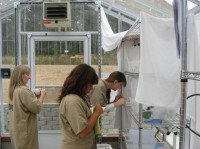By SPP Taylor’s checkerspot program coordinator Lindsey Hamilton
At Mission Creek Corrections Center for Women (MCCCW) four inmate technicians raise Taylor’s checkerspot butterflies as a contribution to the recovery of this prairie species. Following the direction of the Oregon Zoo in Portland, Oregon, they have been successfully rearing and breeding these butterflies for three years. This butterfly was federally listed in October of 2013, which means that anyone working with this species is now held to high accountability and rigorous reporting. The technicians at MCCCW have always been successful at collecting detailed data on all phases of butterfly husbandry.

The Oregon Zoo recently created an Access database that will store all rearing and breeding information for both facilities in one place. This database will increase the quality of all data collected and provide for efficient access for tracking trends and bi-annual reporting.

This has created a new opportunity for the technicians at MCCCW to learn the skill of data entry and management using Access. A computer containing this database was set up in a common living area within the facility last fall, and as simple as this sounds, it represents a major accomplishment for a prison environment! The inmate technicians will now be able to directly enter their data from the program . The Taylor’s checkerspot butterfly program coordinator for SPP, Lindsey Hamilton, will then extract the data via USB and send it to the Oregon Zoo. Butterfly rearing is seasonal work, and the technicians usually have little to do in the off season. With the 2 years of back logged data that needs to be entered, the technicians will stay busy this winter when our caterpillars are sleeping.










